Charles E W Bean, Diaries, AWM38 3DRL 606/257/1 - 1916 - 1927 - Part 20
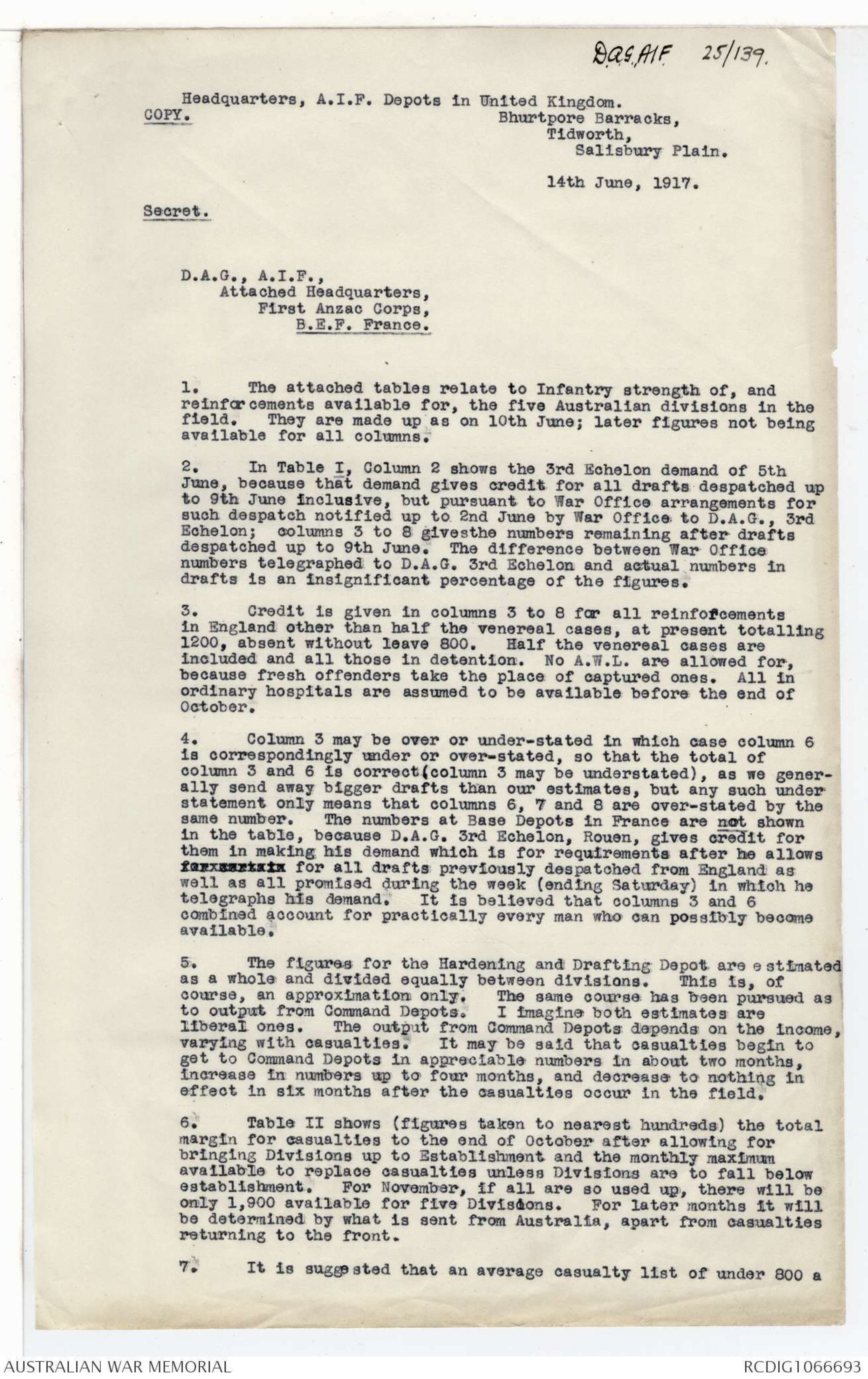
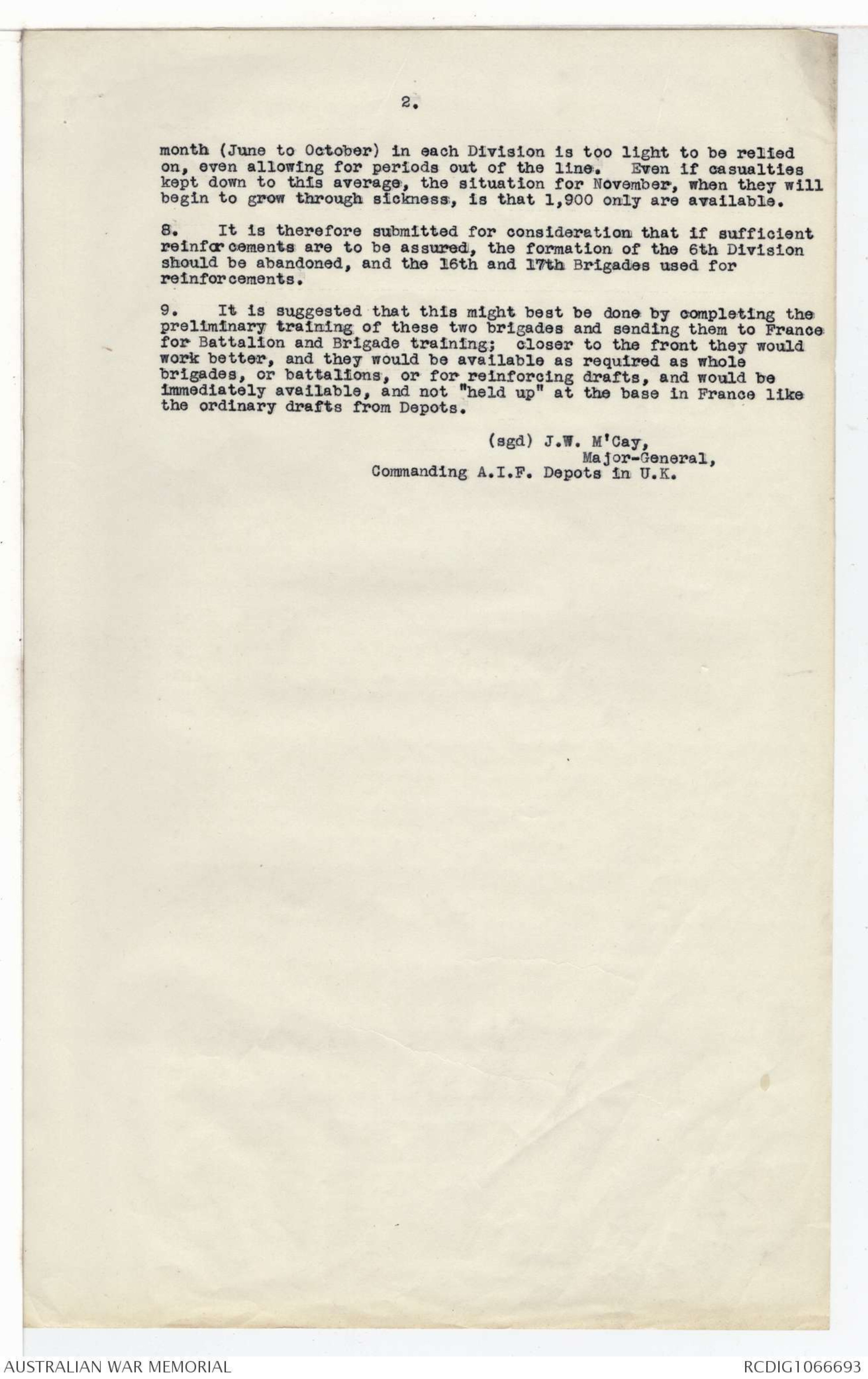
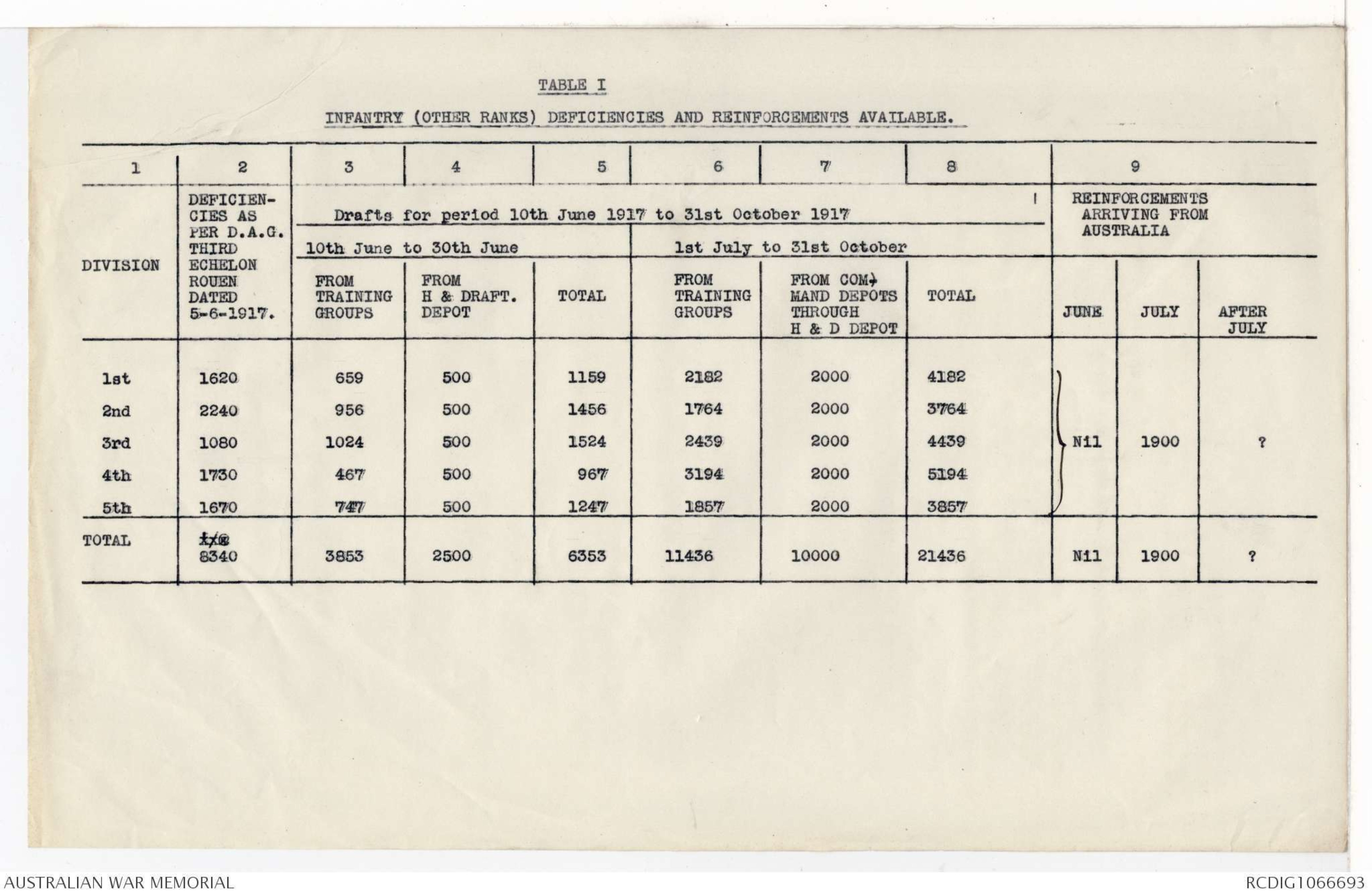
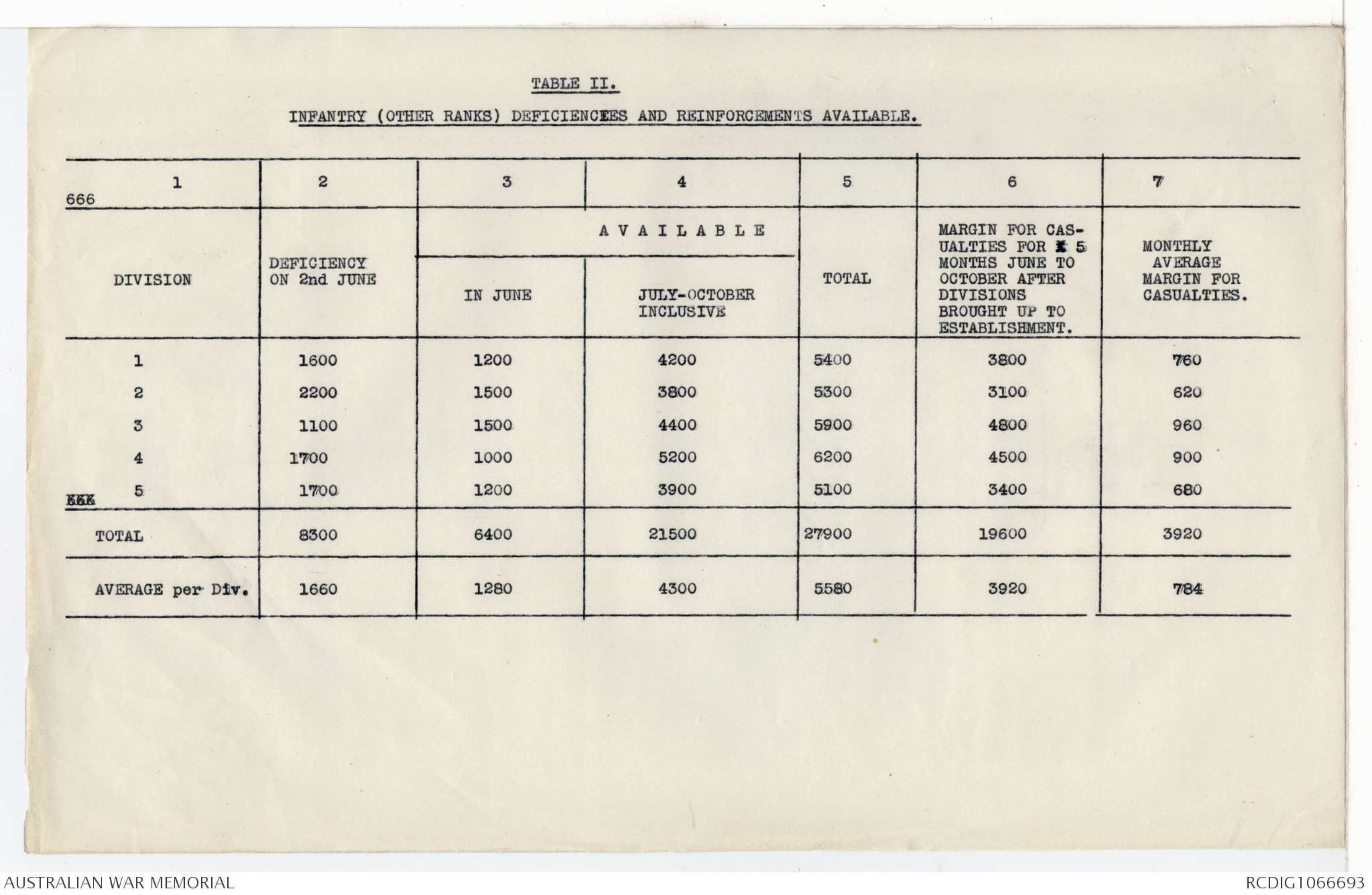
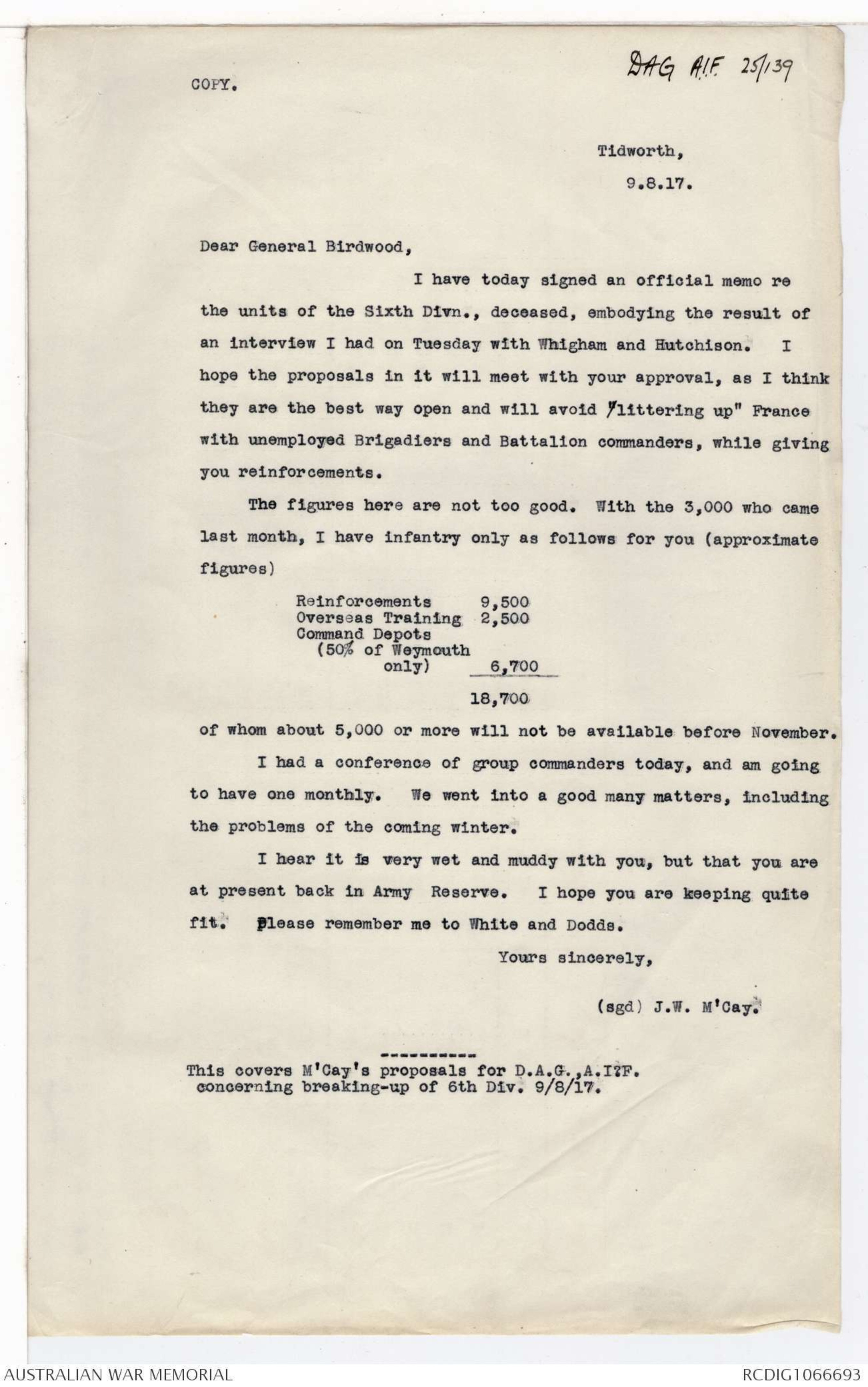
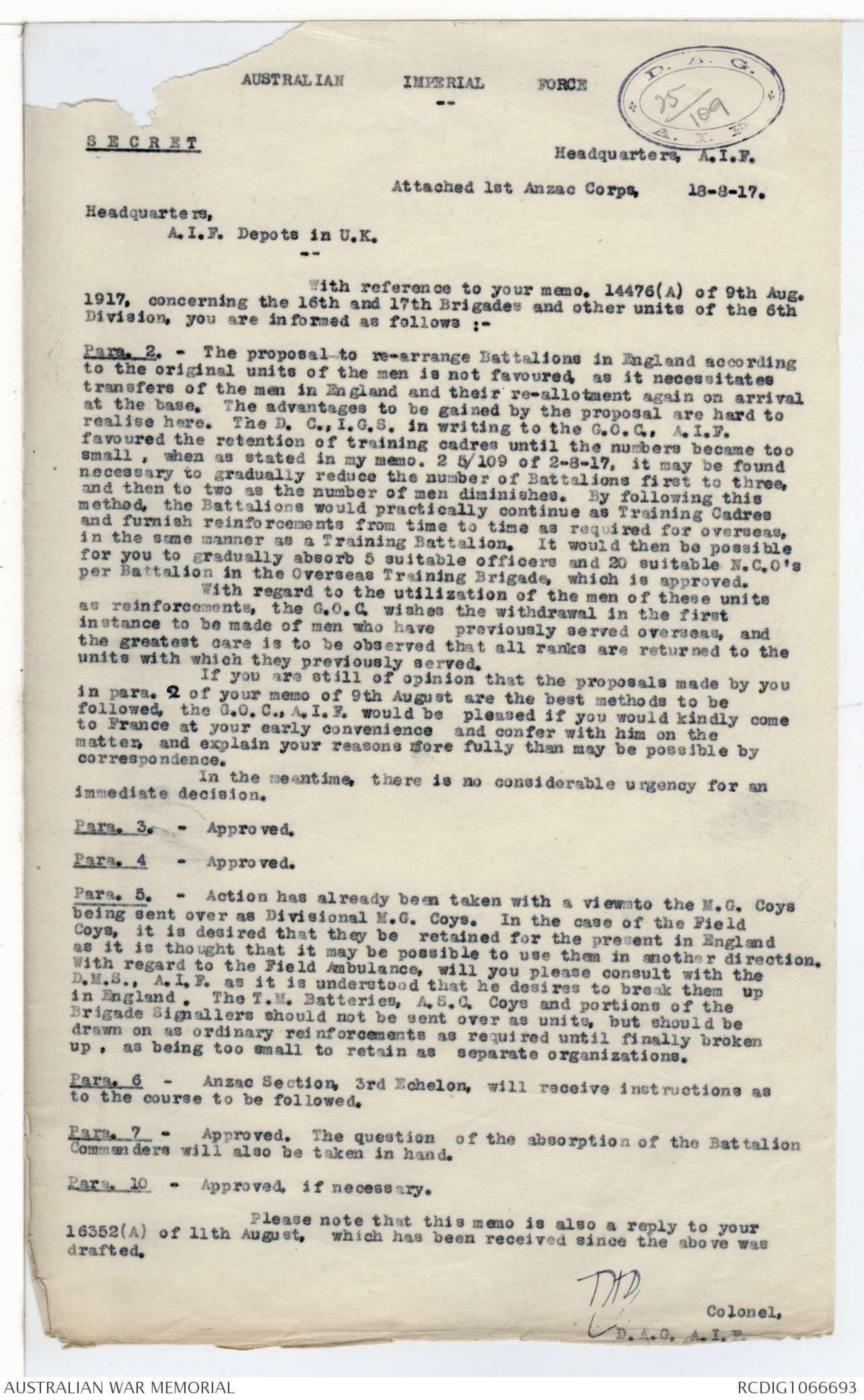
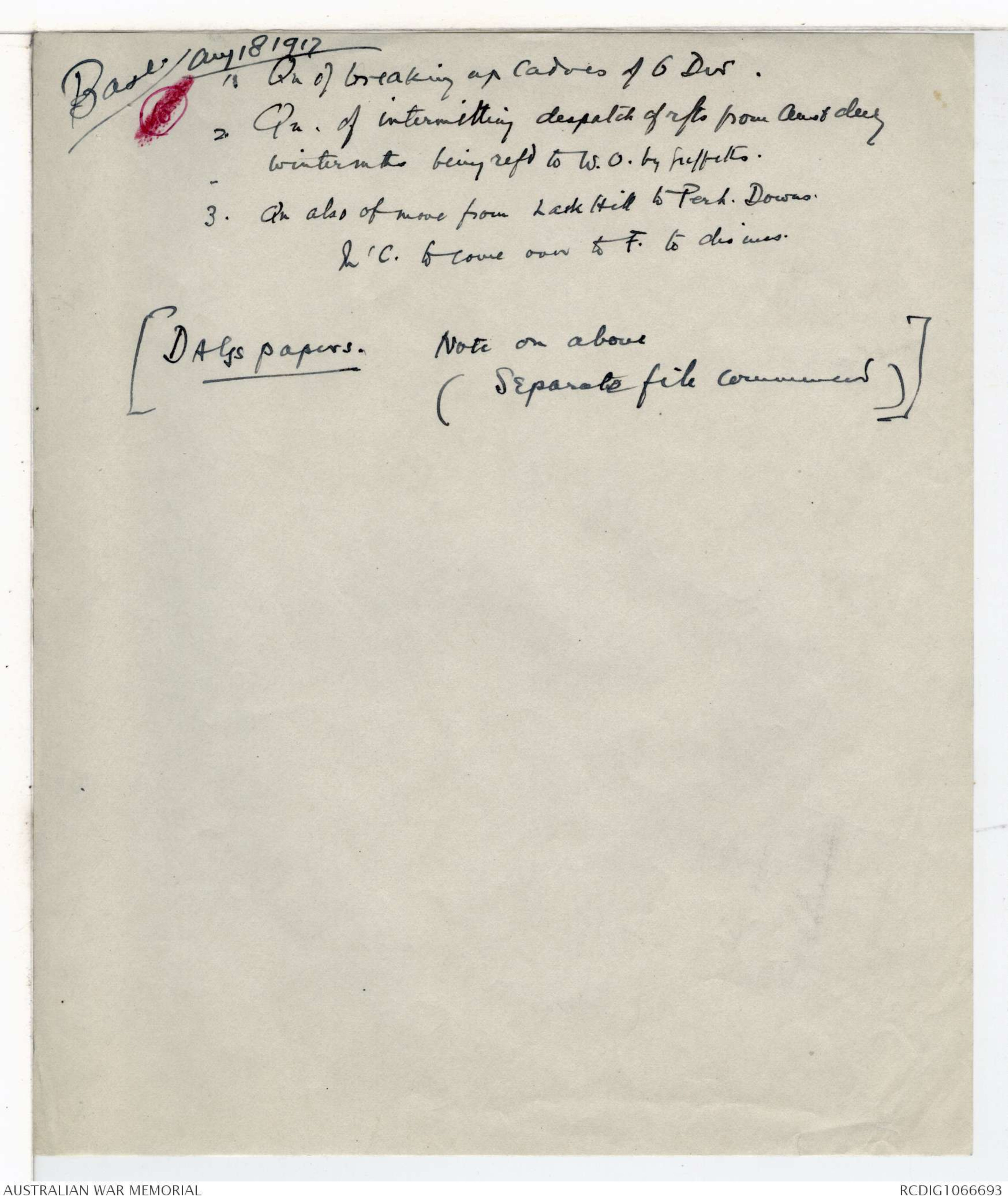
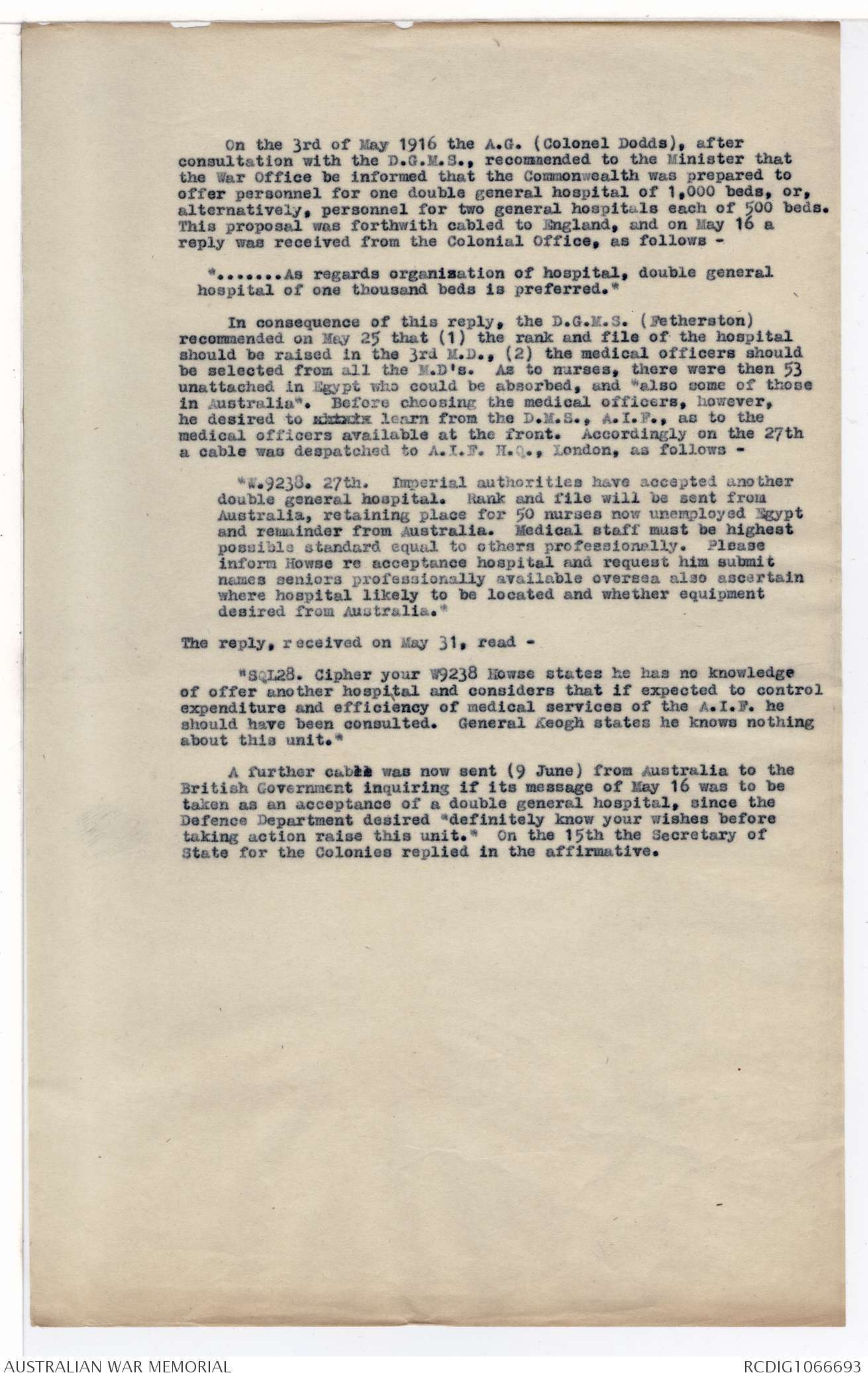
{*D.A.G. AIF 25/139.*]
COPY.
Headquarters, A.I.F. Depots in United Kingdom.
Bhurtpore Barracks,
Tidworth,
Salisbury Plain.
14th June, 1917.
Secret.
D.A.G., A.I.F.,
Attached Headquarters,
First Anzac Corps,
B.E.F. France.
1. The attached tables relate to Infantry strength of, and
reinforcements available for, the five Australian divisions in the
field. They are made up as on 10th June; later figures not being
available for all columns.
2. In Table 1, Column 2 shows the 3rd Echelon demand of 5th
June, because that demand gives credit for all drafts despatched up
to 9th June inclusive, but pursuant to War Office arrangements for
such despatch notified up to 2nd June by War Office to D.A.G., 3rd
Echelon; columns 3 to 8 gives the numbers remaining after drafts
despatched up to 9th June. The difference between War Office
numbers telegraphed to D.A.G. 3rd Echelon and actual numbers in
drafts is an insignificant percentage of the figures.
3. Credit is given in columns 3 to 8 for all reinforcements
in England other than half the venereal cases, at present totalling
1200, absent without leave 800. Half the venereal cases are
included and all those in detention. No A.W.L. are allowed for,
because fresh offenders take the place of captured ones. All in
ordinary hospitals are assumed to be available before the end of
October.
4. Column 3 may be over or under-stated in which case column 6
is correspondingly under or over-stated, so that the total of
column 3 and 6 is correct (column 3 may be understated), as we generally
send away bigger drafts than our estimates, but any such under
statement only means that columns 6, 7 and 8 are over-stated by the
same number. The numbers at Base Depots in France are not shown
in the table, because D.A.G. 3rd Echelon, Rouen, gives credit for
them in making his demand which is for requirements after he allowsfor xxxxx for all drafts previously despatched from England as
well as all promised during the week (ending Saturday) in which he
telegraphs his demand. It is believed that columns 3 and 6
combined account for practically every man who can possibly become
available.
5. The figures for the Hardening and Drafting Depot are estimated
as a whole and divided equally between divisions. This is, of
course, an approximation only. The same course has been pursued as
to output from Command Depots. I imagine both estimates are
liberal ones. The output from Command Depots depends on the income,
varying with casualties. It may be said that casualties begin to
get to Command Depots in appreciable numbers in about two months,
increase in numbers up to four months, and decrease to nothing in
effect in six months after the casualties occur in the field.
6. Table II shows (figures taken to nearest hundreds) the total
margin for casualties to the end of October after allowing for
bringing Divisions up to Establishment and the monthly maximum
available to replace casualties unless Divisions are to fall below
establishment. For November, if all are so used up, there will be
only 1,900 available for five Divisions. For later months it will
be determined by what is sent from Australía, apart from casualties
returning to the front.
7. It is suggested that an average casualty list of under 800 a
2
month (June to October) in each Division is too light to be relied
on, even allowing for periods out of the line. Even if casualties
kept down to this average, the situation for November, when they will
begin to grow through sickness, is that 1,900 only are available.
8. It is therefore submitted for consideration that if sufficient
reinforcements are to be assured, the formation of the 6th Division
should be abandoned, and the l6th and I7th Brigades used for
reinforcements.
9. It is suggested that this might best be done by completing the
preliminary training of these two brigades and sending them to France
for Battalion and Brigade training; closer to the front they would
work better, and they would be available as required as whole
brigades, or battalions, or for reinforcing drafts, and would be
immediately available, and not "held up" at the base in France like
the ordinary drafts from Depots.
(sgd) J.W. M'Cay
Major-General,
Commanding A.I.F. Depots in U.K.
TABLE I
INFANTRY (OTHER RANKS) DEFICIENCIES AND REINFORCEMENTS AVAILABLE.
| 1 | 2 | 3 | 4 | 5 | 6 | 7 | 8 | 9 |
|
DIVISION
|
DEFICIEN- CIES AS PER D.A.G. THIRD ECHELON ROUEN DATED 5-6-1917 |
Drafts for period 10th June 1917 to 31st October 1917 |
REINFORCEMENTS ARRIVING FROM |
|||||
| 10th June to 30th June | Ist July to 31st October | |||||||
| FROM TRAINING GROUPS |
FROM H& DRAFT DEPOT |
TOTAL |
FROM TRAINING GROUPS |
FROM COM-MAND DEPOTS THROUGH H& D DEPOT |
TOTAL |
JUNE JULY AFT JULY |
||
| 1st |
1620 |
659 |
500 |
1159 |
2182 |
2000 |
4182 |
Nil 1900 ? |
| 2nd |
2240 |
956 |
500 |
1456 |
1764 |
2000 |
3764 |
|
| 3rd |
1080 |
1024 |
500 |
1524 |
2439 |
2000 |
4439 |
|
| 4th |
1730 |
467 |
500 |
967 |
3194 |
2000 |
5194 |
|
| 5th |
1670 |
747 |
500 |
1247 |
1857 |
2000 |
3857 |
|
| TOTAL |
8340 |
3853 |
2500 |
6353 |
11436 |
10000 |
21346 |
Nil 1900 ? |
TABLE II
INFANTRY (OTHER RANKS) DEFICIENCIES AND REINFORCEMENTS AVAILABLE.
|
1 666 |
2 | 3 | 4 | 5 | 6 | 7 |
| DIVISION |
DEFICIENCY ON 2nd JUNE |
AVAILABLE | TOTAL |
MARGIN FOR CASUALTIES FOR [ MONTHS JUNE TO OCTOBER AFTER DIVISIONS BROUGHT UP TO ESTABLISHMENT. |
MONTHLY AVERAGE MARGIN FOR CASUALTIES |
|
| IN JUNE | JULY-OCTOBER INCLUSIVE | |||||
|
1 |
1600 |
1200 |
4200 |
5400 |
3800 |
760 |
|
2 |
2200 |
1500 |
3800 |
5300 |
3100 |
620 |
|
3 |
1100 |
1500 |
4400 |
5900 |
4800 |
960 |
|
4 |
1700 |
1000 |
5200 |
6200 |
4500 |
900 |
|
5
|
1700 |
1200 |
3900 |
5100 |
3400 |
680 |
| TOTAL |
8300 |
6400 |
21500 |
27900 |
1960 |
3920 |
| AVERAGE per Div. |
1660 |
1280 |
4300 |
5580 |
3920 |
784 |
[*DAG A.I.F. 25/139*]
COPY.
Tidworth,
9.8.17.
Dear General Birdwood,
I have today signed an official memo re
the units of the Sixth Divn., deceased, embodying the result of
an interview I had on Tuesday with Whigham and Hutchison. I
hope the proposals in it will meet with your approval, as I think
they are the best way open and will avoid "littering up" France
with unemployed Brigadiers and Battalion commanders, while giving
you reinforcements.
The figures here are not too good. With the 3,000 who came
last month, I have infantry only as follows for you (approximate
figures)
Reinforcements 9,500
Overseas Training 2,500
Command Depots
(50% of Weymouth
only) 6,700
18,700
of whom about 5,000 or more will not be available before November.
I had a conference of group commanders today, and am going
to have one monthly. We went into a good many matters, including
the problems of the coming winter.
I hear it is very wet and muddy with you, but that you are
at present back in Army Reserve. I hope you are keeping quite
fit. Please remember me to White and Dodds.
Yours sincerely,
(sgd) J.W. M'Cay.
This covers M'Cay's proposals for D.A.G.,A.I?F.
concerning breaking-up of 6th Div. 9/8/17.
[*D.A.G.
25/109
A.I.F.*]
AUSTRALIAN IMPERIAL FORCE
25/109
SECRET
Headquarters, A.I.F.
Attached 1st Anzac Corps. 18-8-17.
Headquarters,
A.I.F. Depots in U.K.
With reference to your memo. 14476(A) of 9th Aug.
1917, concerning the 16th and 17th Brigades and other units of the 6th
Division, you are informed as follows ;-
Para. 2. - The proposal-to re-arrange Battalions in England according
to the original units of the men is not favoured as it necessitates
transfers of the men in England and their re-allotment again on arrival
at the base. The advantages to be gained by the proposal are hard to
realise here. The D. C.,I.G.S. in writing to the G.O.C., A.I.F.
favoured the retention of training cadres until the numbers became too
small, when as stated in my memo. 2 5/109 of 2-8-17, it may be found
necessary to gradually reduce the number of Battalions first to three,
and then to two as the number of men diminishes. By following this
method, the Battalions would practically continue as Training Cadres
and furnish reinforcements from time to time as required for overseas,
in the same manner as a Training Battalion. It would then be possible
for you to gradually absorb 5 suitable officers and 20 suitable N.C.O's
per Battalion in the Overseas Training Brigade, which is approved.
With regard to the utilization of the men of these units
as reinforcements, the G.O.C wishes the withdrawal in the first
instance to be made of men who have previously served overseas, and
the greatest care is to be observed that all ranks are returned to the
units with which they previously served.
If you are still of opinion that the proposals made by you
in para. 2 of your memo of 9th August are the best methods to be
followed, the G.O.C., A.I.F. would be pleased if you would kindly come
to France at your early convenience, and confer with him on the
matter, and explain your reasons more fully than may be possible by
correspondence.
In the meantime, there is no considerable urgency for an
immediate decision.
Para. 3. - Approved.
Para. 4 - Approved.
Para. 5. - Action has already been taken with a viewmto the M.G. Coys
being sent over as Divisional M.G. Coys. In the case of the Field
Coys, it is desired that they be retained for the present in England
as it is thought that it may be possible to use them in another direction.
With regard to the Field Ambulance, will you please consult with the
D.M.S., A.I.F. as it is understood that he desires to break them up
in England. The T.M. Batteries, A.S.C. Coys and portions of the
Brigade Signallers should not be sent over as units, but should be
drawn on as ordinary reinforcements as required until finally broken
up, as being too small to retain as separate organizations.
Para. 6 - Anzac Section, 3rd Echelon, will receive instructions as
to the course to be followed.
Para. 7 - Approved. The question of the absorption of the Battalion
Commanders will also be taken in hand.
Para. 10 - Approved, if necessary.
Please note that this memo is also a reply to your
16352(A) of 11th August, which has been received since the above was
drafted.
THD
Colonel,
D.A.G. A.I.F.
Base
Aug 18 1917
1. Qn of breaking up Cadres of 6 Div.
2. Qn. of intermitting despatch of rfts from Aust during
winter mths being refd to W.O. by Griffiths.
3. Qn also of move from Lask Hill to Perh. Downs.
In 'C. Glowe our to F. to discuss.
[DAgs papers. Note on above
(Separate file commenced)]
On the 3rd of May 1916 the A.G. (Colonel Dodds), after
consultation with the D.G.M.S., recommended to the Minister that
the War Office be informed that the Commonwealth was prepared to
offer personnel for one double general hospital of 1,000 beds, or,
alternatively, personnel for two general hospitals each of 500 beds.
This proposal was forthwith cabled to England, and on May 16 a
reply was received from the Colonial Office, as follows -
".......As regards organization of hospital, double general
hospital of one thousand beds is preferred."
In consequence of this reply, the D.G.M.S. (Fetherston)
recommended on May 25 that (1) the rank and file of the hospital
should be raised in the 3rd M.D., (2) the medical officers should
be selected from all the M.D's. As to nurses, there were then 53
unattached in Egypt who could be absorbed, and "also some of those
in Australia". Before choosing the medical officers, however,
he desired to xxxxxx learn from the D.M.S., A.I.F., as to the
medical officers available at the front. Accordingly on the 27th
a cable was despatched to A.I.F. H.Q., London, as follows -
"W.9238. 27th. Imperial authorities have accepted another
double general hospital. Rank and file will be sent from
Australia, retaining place for 50 nurses now unemployed Egypt
and remainder from Australia. Medical staff must be highest
possible standard equal to others professionally. Please
inform Howse re acceptance hospital and request him submit
names seniors professionally available oversea also ascertain
where hospital likely to be located and whether equipment
desired from Australia."
The reply, received on May 31, read -
"SQL28. Cipher your W9238 Howse states he has no knowledge
of offer another hospital and considers that if expected to control
expenditure and efficiency of medical services of the A.I.F. he
should have been consulted. General Keogh states he knows nothing
about this unit."
A further cable was now sent (9 June) from Australia to the
British Government inquiring if its message of May 16 was to be
taken as an acceptance of a double general hospital, since the
Defence Department desired "definitely know your wishes before
taking action raise this unit." On the 15th the Secretary of
State for the Colonies replied in the affirmative.
 Sam scott
Sam scottThis transcription item is now locked to you for editing. To release the lock either Save your changes or Cancel.
This lock will be automatically released after 60 minutes of inactivity.